Sister systems NāgarīŚāradā | ||
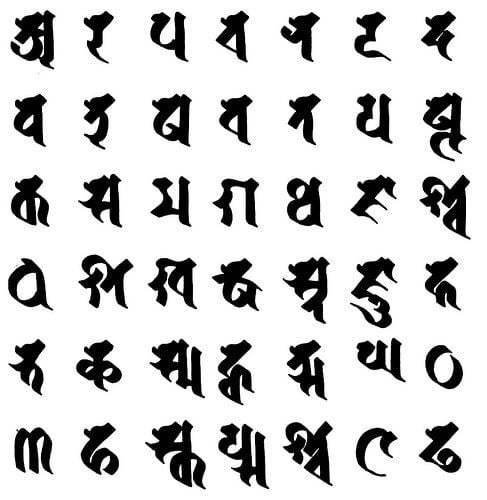 | ||
Time period c. 600–c. 1200 in India, and to the present in East Asia Parent systems Aramaic alphabetBrahmi scriptGuptaSiddhaṃ | ||
Siddhaṃ, also known in its later evolved form as Siddhamātṛkā, is the name of a script used for writing Sanskrit from c. 600-1200. It is descended from the Brahmi script via the Gupta script and later evolved into the Assamese alphabet, the Bengali alphabet, and the Tibetan alphabet. There is some confusion over the spelling: Siddhāṃ and Siddhaṃ are both common, though Siddhaṃ is preferred as "correct". The script is a refinement of the script used during the Gupta Empire.
Contents

The word Siddhaṃ means "accomplished" or "perfected" in Sanskrit. The script received its name from the practice of writing Siddhaṃ, or Siddhaṃ astu (may there be perfection), at the head of documents. Other names for the script include bonji (Japanese: 梵字) lit. "Buddhist characters" and "Sanskrit script") and Chinese: 悉曇文字; pinyin: Xītán wénzi lit. "Siddham script".

Siddhaṃ is an abugida rather than an alphabet because each character indicates a syllable, but it does not include every possible syllable. If no other mark occurs, the short 'a' is assumed. Diacritic marks indicate the other vowels, anusvara, and visarga. A virama can be used to indicate that the letter stands alone with no vowel, which sometimes happens at the end of Sanskrit words.
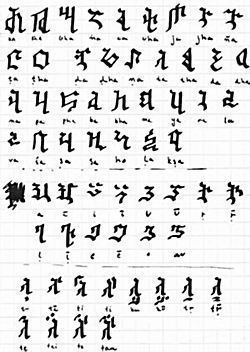
History
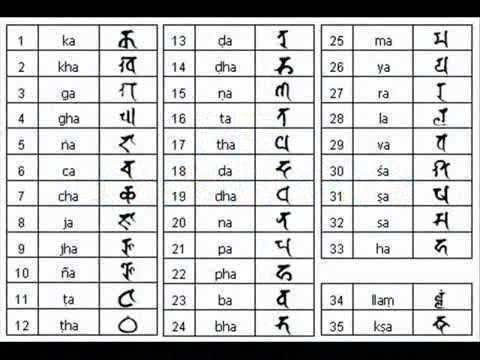
Many Buddhist texts taken to China along the Silk Road were written using a version of the Siddhaṃ script. This continued to evolve, and minor variations are seen across time, and in different regions. Importantly it was used for transmitting the Buddhist tantra texts. At the time it was considered important to preserve the pronunciation of mantras, and Chinese was not suitable for writing the sounds of Sanskrit. This led to the retention of the Siddhaṃ script in East Asia. The practice of writing using Siddhaṃ survived in East Asia where Tantric Buddhism persisted.
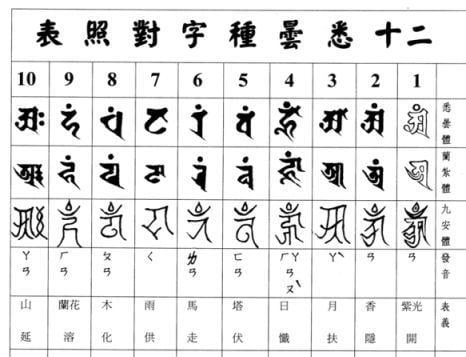
Kūkai introduced the Siddhaṃ script to Japan when he returned from China in 806, where he studied Sanskrit with Nalanda-trained monks including one known as Prajñā (Chinese: 般若三藏; pinyin: Bōrě Sāncáng, 734–c. 810). By the time Kūkai learned this script, the trading and pilgrimage routes over land to India, were closed by the expanding Abbasid Caliphate.
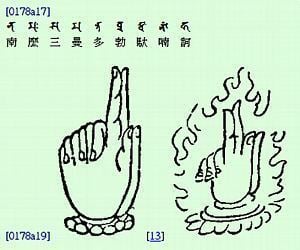
In Japan the writing of mantras and copying of Sutras using the Siddhaṃ script is still practiced in the esoteric schools of Shingon Buddhism and Tendai as well as in the syncretic sect of Shugendō. The characters are known as shittan (悉曇) or bonji (梵字, Chinese: Fànzì). The Taishō Tripiṭaka version of the Chinese Buddhist canon preserves the Siddhaṃ characters for most mantras and Korean Buddhists still write bījas in a modified form of Siddhaṃ. A recent innovation is the writing of Japanese language slogans on T-shirts using Bonji. Japanese Siddhaṃ has evolved from the original script used to write sūtras and is now somewhat different from the ancient script.
It is typical to see Siddhaṃ written with brushes like Chinese writing, and it is also written with a bamboo pen; in Japan, a special brush called a bokuhitsu (朴筆, Chinese: pokbat) is used for formal Siddhaṃ calligraphy. The informal style is known as "fude" (筆, Chinese: "moubat").
In the middle of the 9th century, China experienced a series of purges of "foreign religions", thus cutting Japan off from the sources of Siddhaṃ texts. In time, other scripts, particularly Devanagari replaced Siddhaṃ in India, while in Bengal, Siddhaṃ evolved to become the Bengali alphabet, leaving East Asia as the only region where Siddhaṃ is used.
There were special forms of Siddham used in Korea that varied significantly from those used in China and Japan, and there is evidence that Siddham was written in Central Asia as well by the early 7th century.
As was done with Chinese characters, Japanese Buddhist scholars sometimes created multiple characters with the same phonological value to add meaning to Siddham characters. This practice, in effect, represents a 'blend' of the Chinese style of writing and the Indian style of writing and allows Sanskrit texts in Siddham to be differentially interpreted as they are read, as was done with Chinese characters that the Japanese had adopted. This led to multiple variants of the same characters.
With regards to directionality, Siddham texts were usually read from left-to-right then top-to-bottom, as with Indic languages, but occasionally they were written in the traditional Chinese style, from top-to-bottom then right-to-left. Bilingual Siddham-Japanese texts show the manuscript turned 90 degrees clockwise and the Japanese is written from top-to-bottom, as is typical of Japanese, and then the manuscript is turned back again, and the Siddham writing is continued from left-to-right (the resulting Japanese characters look sideways).
Over time, additional markings were developed, including punctuation marks, head marks, repetition marks, end marks, special ligatures to combine conjuncts and rarely to combine syllables, and several ornaments of the scribe's choice, which are not currently encoded. The nuqta is also used in some modern Siddham texts.
Siddhaṃ Fonts
Siddhaṃ is still largely a hand written script. Some efforts have been made to create computer fonts though to date none of these are capable of reproducing all of the Siddhaṃ conjunct consonants. Notably the Chinese Buddhist Electronic Texts Association have created a Siddhaṃ font for their electronic version of the Taisho Tripiṭaka, though this does not contain all possible conjuncts. The software Mojikyo also contains fonts for Siddham, but split Siddham in different blocks and needs different fonts to render one document.
A siddhaṃ input system relies on the CBETA font, Siddhamkey 3.0 has been produced.
Unicode
Siddham script was added to the Unicode Standard in June 2014 with the release of version 7.0.
The Unicode block for Siddham is U+11580–U+115FF:
